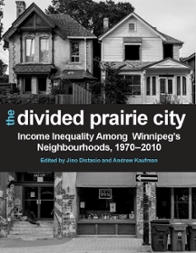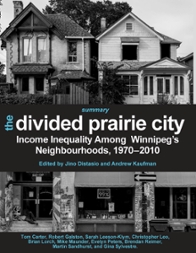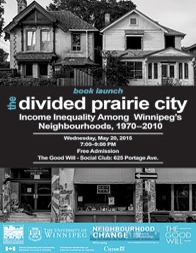IUS Releases The Divided Prairie City
Sat. Jun. 20, 2015
Join us for a night of thought-provoking discussion.
The Institute of Urban Studies at the University of Winnipeg is proud to announce the release of a new edited collection on how income inequality manifests at the neighbourhood level in Winnipeg. This book brings twelve experts on Winnipeg to talk about the people, places, and spaces, impacted by a growing gap between rich and poor neighbourhoods. We add a geographic perspective to the recent conversations about Winnipeg's economic and racial divides.
--------------
Panelists:
--------------
Rosanna Deerchild (Poet; Storyteller; Broadcaster, CBC, NCI-FM)
Jarita Greyeyes (Manager, Wii Chiiwaakanak Learning Centre, University of Winnipeg)
Steve Lafleur (Senior Policy Analyst, Frontier Centre for Public Policy)
Richard Milgrom (Associate Dean Research, Associate Professor and Head, Department of City Planning, University of Manitoba)
Molly McCracken (Director, Canadian Centre for Policy Alternatives - Manitoba)
-----------------
Background
-----------------
The IUS is part of a Neighbourhood Change Research Partnership (NCRP) funded by the Social Sciences and Humanities Research Council of Canada (SSHRC). Led by the Cities Centre at the University of Toronto, this study examines income inequality in Halifax, Montreal, Toronto, Hamilton, Winnipeg, Calgary, and Vancouver.
Both income inequality and polarization are intensifying within Canadian cities. This growing wealth gap creates new socio-economic, ethno-cultural, and spatial divisions in the urban environment. And while social division and inequality are hardly new issues in Winnipeg, recent media attention has highlighted significant divides in the city. This edited collection adds another voice to these conversations by exploring how income inequality and polarization impact people and spaces in an increasingly divided prairie city.
Neighbourhoods matter: where we live influences our quality of life and the services we receive. Some neighbourhoods provide us with advantages and social connections that allow us to thrive. Other neighbourhoods can make existing gaps worse because they lack resources and opportunities. Studying the geography of inequality shows how ideas, processes, and policies work together to create our city while also informing program and policy.
 |
 |
 |
